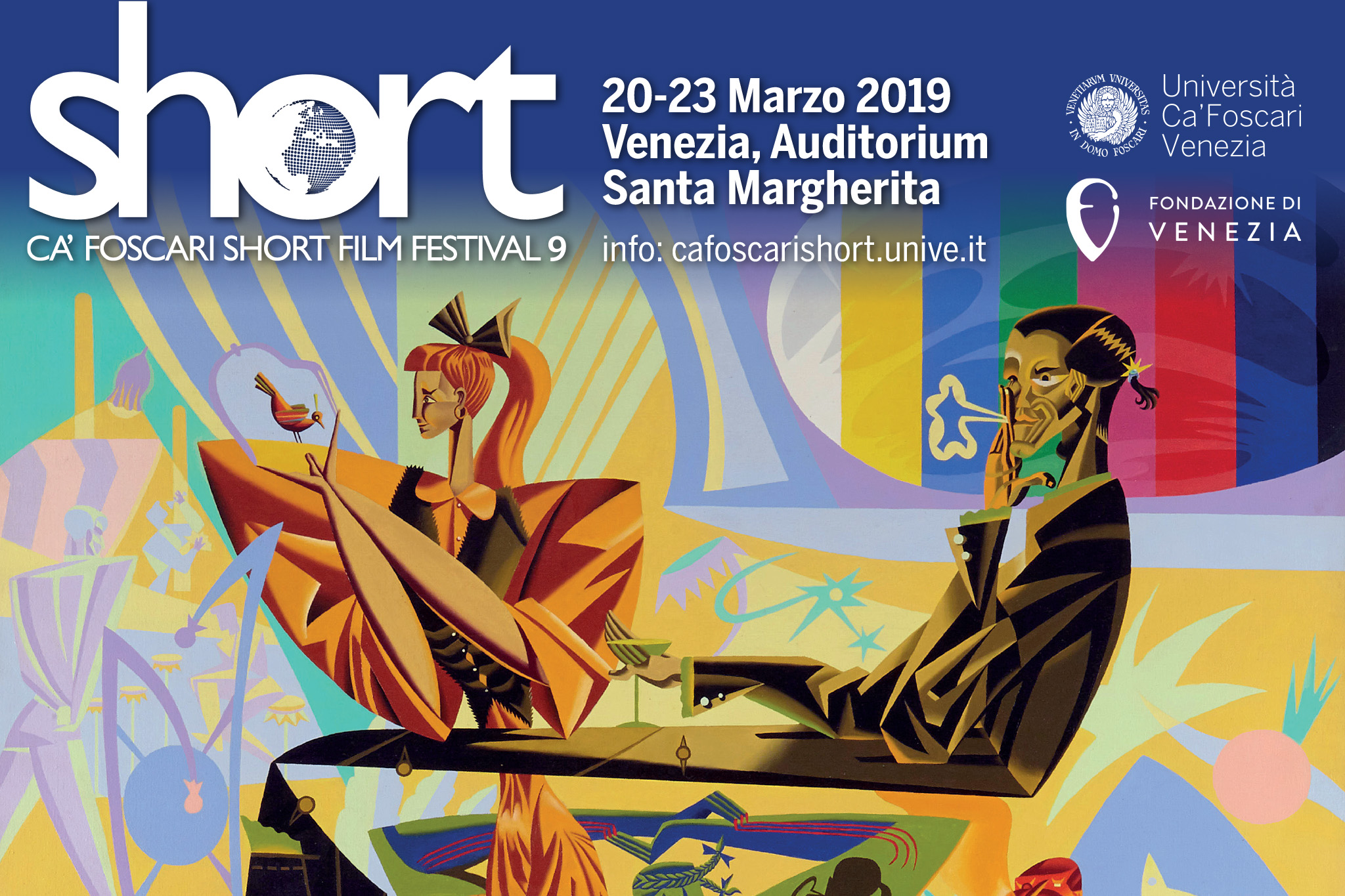
CARRANO’S MASTERCLASS: “FILM IS SOMETHING ALIVE”
THE THIRD DAY OF THE CA’ FOSCARI SHORT FILM FESTIVAL 9
IMMIGRATION AT THE CENTER OF THE SHORT FILMS OF THE INTERNATIONAL COMPETITION
AND MUCH MORE: THE FINALISTS OF THE MUSIC VIDEO COMPETITION, ITALIAN VIDEO ART WITH “THE SUSPENDED GLANCE”, “PASINETTI” VIDEO COMPETITION AND VIDEO-OKE!
The Italian experimental animator Leonardo Carrano was the protagonist of the suggestive masterclass held yesterday, which has captured the audience in the Santa Margherita Auditorium, when the public was literally wrapped in the film that the artist uses for his animated creations. A performative moment which perfectly represents Carrano’s art: impossible to frame in labels or specific expressive methods. This aspect is shown by the incredible quantity of materials used to compose his creations, because: “animation doesn’t only mean animated drawing, it is a diverse world, composed by numerous different techniques.”
From this perspective, Carrano was surely influenced by the work and the thoughts of artists like Aldo Braibanti and Nato Frascà, and more in general by the Roman Vanguardism of the 60s. While talking to the audience he remembered some of the key figures of the movement, such as Alberto Grifi, sharing some anecdotes like the fact that Grifi wanted to have Frascà by his side in his final hours.
During the conversation with Paola Bristot, professor at the Academy of Fine Arts of Venice, Carrano explained that in his works film has a fundamental importance, as on each occasion it gets modified, carved, pierced, and glued. Carrano uses the same instruments that he used to work with during its time as a carver, applying it to cinema and to physical modifications of material, because “film is alive”.
Carrano then presented the works that he produced in over twenty years of activity, starting from Penthesilea (1996), a project dedicated to the Italian activist Silvia Barandini. In this work, abstraction, esoteric iconography, and musical composition are merged with experiments of unusual animation techniques, giving life to a unique piece of art which already shows the seeds of his later works. In The circle and the threshold (1999) and Noiselevel (2002) we can see an even greater will to experiment through technology, using computer animation realized with a 3D scanner. Aeterna (2012) is definitely a film-concept: a long confrontation with Mozart Requiem Mass in D minor K 626. For each of the 14 musical movements, Carrano has realized some video-animations, each with a different technique and in collaboration with a different animator or video-artist. One of his most recent works, Jazz for a massacre (2014), has inspired great fascination from the public. The film was directed together with Giuseppe Spina, and features jazz impros which go together with techniques of painting, carving and acidification of 35 mm film. In 2017 Carrano created Macula, which soundtrack was composed by Ennio Morricone and sung by Antonio Rezza, in which for the first time he experimented the encaustic technique on film.
The third day of the Ca’ Foscari Short Film Festival opened with the screening of the short films of the Video Contest “Francesco Pasinetti”, historical partner of the Short who for sixteen editions has been keeping the city of Venice as his focus, telling its life and tradition through cinema while keeping an eye on the present and the prospects for the future. Among the short films presented, winners of the various sections of the last edition of Video Contest, we can also find the winner of the first prize: A man called Toni by Marta Pasqualini whose protagonist is a craftsman from Murano; and The Day by Pippo Mezzapesa the winner of the Photography Prize and Prize for best “Documentary and Documentation”, section inaugurated in the last edition, films that deals with the story of Paola Clemente, an Apulian farmworker who died of fatigue while working under the sun in the Southern fields.
The day continued with the Music Video Competition, a side contest for music videos made by students from universities and film schools around the world, which reached the third edition this year and is curated by Giovanni Bedeschi. The finalist videos were: Mirrors and the message, by Marie Lavis from Switzerland, My darlin’ by Edy Szewy from the United Kingdom, from Germany we had Mairimasil by Jakob Werner and Get well soon by Katharina Hauke. Italy is represented by Frank di Filippo di Piramo and Sand Castles by Roberta Palmieri, and the other finalists are: They won’t let a dream come true by the Pakistani Shumaila Kanwal, Fool by Al Kalyk, Yokai by Eirik Heggen, Dust & Ashes by Kate Koroleva, and Smth on point by the Polish Aleksander Krzystyniak. The winner will be revealed tomorrow during the closing ceremony.
Between the two programs there was also a nice interlude with the Video-oke!, the playful moment of the Short, which involves classes of Venetian high school students who can thus approach cinematography in a new, fun and educational way: reinterpreting scenes of famous films while the images flow on the screen without the voices of the original actors, an appointment now in its fifth edition.
A recurring event is also The suspended Glance, the special program curated by the video artist Elisabetta Di Sopra dedicated to the most recent Italian video art. The underlying theme of the selected works this year is the human body, the undisputed protagonist in the language of our video art, obviously with different methods and sensibilities which can be driven by gender differences among artists. Two points of views facing one another, two different worlds of images and sounds coexisting and interacting. This edition also saw the prestigious involvement of Enrico Tomaselli, curator and expert in cultural management, and founder and artistic director of the Magmart festival. The collaboration brought to the screen of our Auditorium works like Avant la nuit by Chiara Caterina, a reflection on a prison in the center of a European capital; The burning by Francesca Fini inspired by the recent alarming political events in America; and Paolo Bandinu‘s Meandro rosso which pays homage to the visionary intuitions of three great directors with a pictorial reinterpretation.
The day then continued with six short films from the International Competition. Philipp Westerfeld presented No Smoking Indoor, a rule that becomes the emblem of a problematic relationship between an elderly lady and her husband. Afterward, it was the turn of Anthony Xavier‘s The Sons of Silence: a metaphor featuring a boxer and protests against the Venezuelan regime. It was then the turn of Don Senoc with In Between Spaces, a story set in the Philippines, where the bond between two brothers, Dita and Mako, becomes stronger and more intense in the moments right before their separation. The English director Ollie Gardner was able to excite the Auditorium Santa Margherita with his The Sunday Night Drinkers Club, the true story of four childhood friends trying facing the illness of one of the four. The fifth film presented was Fernanda’s Spring by Estevan de la Fuente and Débora Zanatta, an optimistic account of the socio-economic difficulties of the LGBTQUI+ world set in Brazil. Lalo’s House by the Beninese-American Kelley Kali closed the first group of screenings. The film, based on a true story, is a social accusation against kidnapping, violence and child abuse in Haiti.
Finally, the last short films of the International Competition were presented. Clandestine, shot by the Spanish director Gerard Vidal-Cortes, has a unique point of view on the question of migration, as it shows the perspective of a human trafficker, and it counterpoises it to the fear of those who decide to endure the violence in hope of reaching a better future. Then, it was the turn of the Polish film Sashka, by Katarzyna Lesisz, another tale of immigration that sees as protagonist a young Ukranian woman that undergoes an arranged marriage to obtain her visa. The same theme links this short to Raheel, by the Iranian director Ayat Asadi Rahabar, which illustrates the psychology of migration through the story of an Afghan woman travelling to Iran in search of her husband. The film focuses on how the journey toward a destination can change one’s own perspective.
Next, the English movie Dirty Little rascal, directed by Ben Bovington-Key, was projected. The short film focuses on the friendship between two teenagers, Reg and Dom, bounded by the goal of achieving the erotic clippings that Reg’s grandma hides in a little basket of her room. A mix between circus and musical atmosphere originates from Deadestiny, by the French directors Quentin Porte and Jean-Baptiste Beltra. The movie is set in an old haunted palace, in which the protagonist becomes the spectator of a grotesque ghost show of contrasting sonorities.
The Competition ended back in Italy, with Così in terra, by Pier Lorenzo Pisano, set in the municipality of Acquasanta Terme, in the region of Marche, which faces the devastation of the 2016 earthquake, and the scars it left over the village’s inhabitants. The protagonist is Roberto Citran, playing the village’s priest. In the evening the Jury Special Program will be presented, where the three members of the Jury of the International Competition, Teresa Cavina, Ayat Najafi e Ülo Pikkov, will meet the public and will present some short films which they directed or chose for the occasion

